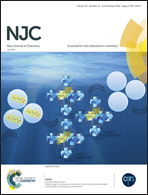Facile synthesis of hierarchical porous solid catalysts with acid–base bifunctional active sites for the conversion of cellulose to 5-hydroxymethylfurfural
Abstract
Herein, rod-shaped modified halloysite nanotubes (m-HNTs) with suitable wettability and basic active sites were utilized as stable particles to stabilize W/O Pickering HIPEs. Immediately following the thermal polymerization treatment and the subsequent sulfonation process, we have synthesized hierarchical porous solid catalysts (HPSCs) with acid–base bifunctional active sites. The as-prepared HPSCs have hierarchical meso–macroporous structures, strongly acidic surfaces and basic catalytic active sites, which can remarkably improve the catalytic activity for the conversion of cellulose to 5-hydroxymethylfurfural (HMF). This suggests that the stable particles with basic active sites embedded in the porous structure of HPSCs can significantly improve the catalytic activity. The results showed that a maximum yield of HMF (45.6%) can be obtained and the catalyst was recycled in four consecutive cycles without significant loss of catalytic activity. Moreover, this provides a new way for the development of multistage pore structure catalysts for catalytic conversion of carbohydrates.



 Please wait while we load your content...
Please wait while we load your content...